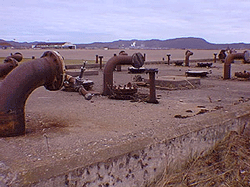Pinetree Radar Base: Environmental Concerns
This page is from a heritage partnered project. It was written in 1998 by students from Stephenville Integrated High School and edited by their teachers. It has not been vetted by the heritage website's academic editor.
In 1941 the United States Air Force established a military base in Stephenville, NL. This base was operational for twenty-four years. During that time the Americans constructed underground storage tanks and pipelines, with the sole intention of storing fuel. In addition, several buildings were constructed for the storage and handling of various chemicals and hazardous products. As a direct result of the Earnest Harmon Air Force Base, there were significant environmental concerns associated with Stephenville and the surrounding areas.
Assessing Military Remains
During the late 1990s an environmental audit and assessment of the area was undertaken by the Newfoundland and Labrador Housing Corporation to determine what type of clean up was required. The audit included extensive surveys and research of abandoned fuel lines, underground storage tanks, abandoned buildings and their environmental and health risks.

Pipe Line Concerns
A major area of concern was the American infrastructure of underground fuel lines in the Stephenville (Harmon) industrial area. It had been assumed that these pipelines had been drained in 1966 when the Americans closed the base. However, several incidents occurred which proved they still contained oil and gas. In 1993, for example, during the construction of the Regional Aquatic Centre, a construction team hit and broke a gas pipe. Gas began to seep into the ground but no effort was made to clean up the spill, since no information of the pipes existed. It had been reported that due to the acidic soil in Newfoundland, the lifespan of these pipes was fifteen to twenty-five years. Most of these pipes however, were around for decades. Radiologic surveys were performed to confirm the location of the pipes and the amount of fuel they contain. The results of the survey identified six full lines, all of which were confirmed full of liquid. Testing of the liquids told us the pipes contained a mixture of light fuel, J-P4 fuel, diesel oil, AVGAS, and diesel fuel. Had this type of spill occurred in Stephenville which was connected via the same pipelines, the results could have been disastrous due to the high risk of fire and explosion.

Many people felt the audit did an excellent job on the area it studied, but it did not study the dumpsites left by the Americans. Nineteen former dumpsites were located in the area, including the major dumpsite in the Igloo Road and heavy equipment school area. According to Cecil Stein, mayor of Stephenville at the time, these dumps drained into the water supply catchment areas and was basically a time bomb ready to go off. The town intended to develop an artesian well system for the citizens of Stephenville. Although the dumps would no longer be a risk to the water supply, they would still have had to be cleaned-up. Both Igloo Road and the heavy equipment school were believed to be massive dumps. No one knew for sure what had been dumped there, but there were many stories circulating. One such story stated that chemicals, vehicles with oil and gas, 45 gallon drums and dry cleaning fluids had been dumped there. This was obviously an area which required further testing.

The Legacy of the Military Base
As a strategic refuelling site, large quantities of various fuels were stored on the base in underground storage tanks. They were owned by several companies including Abitibi Consolidated. Research done on the inactive tanks indicated a total measured quantity of 81,000 litres of product. This product consisted of 16% light fuel and 84% diesel fuel. As well leaked fuel had been identified in the water table around several of these tanks.
Another legacy of the base was a number of abandoned buildings vacated by the Americans. Two such buildings were the Brewery building and the Roundhouse. The NLHC had torn down the brewery which was used as an automotive garage. This building was believed to be a site of all sorts of toxic dumping, which was not only an environmental hazard, but a health risk. The Roundhouse was located between Massachusetts and Illinois drive. It was where the Americans turned their train around, using tracks.
The Roundhouse was slated for demolition, but many people felt tests should have been performed first. The building had been a topic of controversy, as it had been argued by some residents that it once housed Agent Orange. Agent Orange had been linked to birth defects, rare cancers and other illnesses. It was a chemical used by the Americans to keep alders from growing onto the railroad tracks. It was suspected that the Agent Orange waste was dumped near the roundhouse. Several people who worked in this building died of cancer and their families wanted answers. The American government paid compensation to ex-servicemen and their families, who were exposed to the chemicals and experienced a wide variety of illnesses. Many people argued it was suspicious why this was the first building to be torn down.
It had been decades since the Americans left Stephenville and several people wondered why the clean up took so long to get underway. Many people felt the main reason for the clean up of Stephenville and the surrounding area was the discovery of toxic waste in Argentia, another American base, located on the Avalon Peninsula. Following the publication of the study by AGRA, an engineering consulting firm, most of the storage tanks in Stephenville were emptied, the pipelines drained, and both the brewery and roundhouse torn down. Further study was planned for the dumpsites.




